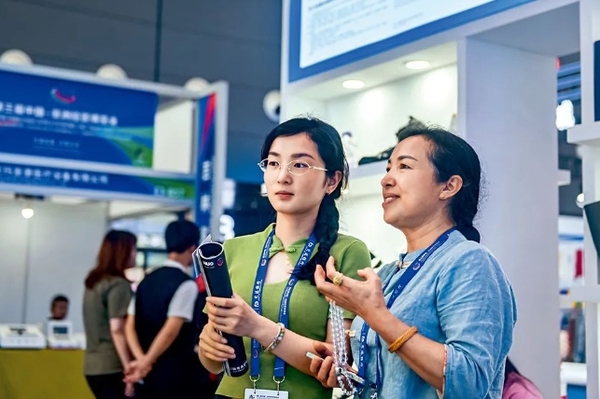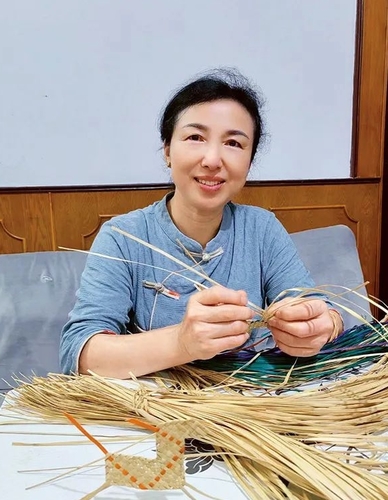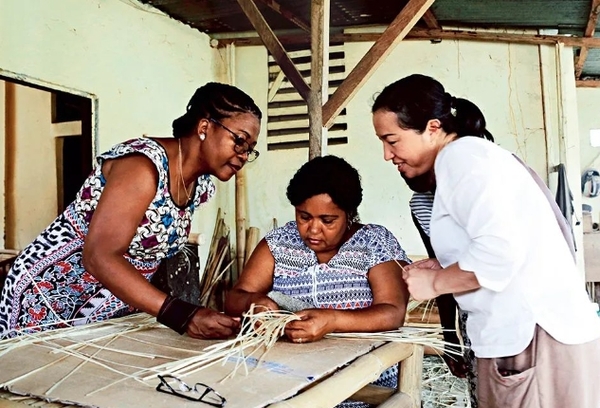Weaving Bright Future for Chinese, African Women

The third China-Africa Economic and Trade Expo, with the theme Common Development for a Shared Future, was held in Changsha, capital of Central China's Hunan Province, from June 29 to July 2. Representatives of 53 African countries, and from multiple international organizations, attended.
Hu Xiaoqin, an inheritor of the intangible cultural heritage Linwu (a county in Chenzhou, a city in Hunan Province) Chinese alpine rush-weaving craft and president of Xiangfei Weaving Crafts Co., Ltd., was one of the 32 exhibitors who represented Chenzhou during the expo.
Big Stage
"We have made specially designed products for this expo, including fans, sun hats, with wide brims, and rings, bracelets and earrings. These products were well-received by exhibitors and visitors," Hu says.
Hu was attending the expo for the third time. "In the context of the 10th anniversary of the BRI, it is a great honor for me to attend the expo as a representative of women entrepreneurs from Chenzhou," Hu says.
The biennial expo, first held in 2019, has become a major platform for strengthening economic and trade cooperation between China and African countries. The China-Africa Achievement Exhibition on High-Level Building of the Belt and Road Initiative and the Exhibition on China-Africa Women's Innovation and Entrepreneurship were held during the expo for the first time.
"With the BRI gaining momentum in Africa, China-Africa economic and trade cooperation has strengthened, and entered a new stage of high-quality development. During the expo, I met one of my old friends, from Angola, who also attended the event as an exhibitor. We became friends when I did international trade business in Angola a decade ago," Hu says.
Nearly 1,600 categories of goods from 29 African countries were exhibited, an increase of 166 percent over the previous expo. The number of exhibitors also increased to 1,500, up 70 percent over the previous expo.

"The delegation of Zambia and South Africa visited Chenzhou after the expo. Along with the building of BRI, the economic and trade exchanges between Chenzhou and Africa have become increasingly frequent, and the friendship between Chenzhou and Africa has also deepened," Hu says.
Hu introduced the characteristics of Chinese alpine rush-woven products, and related product innovation and development, to the delegation. Chinese alpine rush is a kind of grass that thrives on the mountains of Linwu. Chinese alpine rush-weaving craft has a profound history in Linwu. More than 600 years ago, the locals began using Chinese alpine rush to make mats, and the mats gradually became well-known.
In 1954, mats made with Chinese alpine rush were exhibited at the Leipzig Trade Fair, held in Leipzig, Germany, and they were referred to as "the world's unique handicrafts." In 2014, the Chinese alpine rush-weaving craft was added to Chenzhou's list of municipal intangible cultural heritage.
To better inherit and spread Chinese alpine rushweaving skills, Hu in 2016 established Xiangfei Weaving Crafts Co., Ltd. "With a spirit of innovation, we have created nearly 100 kinds of woven products. We also produce tailor-made products for our customers. We can weave whatever our customers like. I have organized many activities to teach students and young people the weaving skills, and to let them experience the charm of intangible cultural heritage," Hu says
"Our products are natural, environmentally friendly handicrafts, which are sold at home and abroad. I hope more Chinese and foreign people will know the intangible cultural heritage of Chinese alpine rushweaving skills, and that more people will like our products."
 |
Building Dream in Africa
Hu has forged an indissoluble bond with Africa. Between 1998 and 2005, she visited the Democratic Republic of Sao Tome and Principe twice, and Guinea-Bissau once, to teach African women the weaving skills. She also conducted international trade in Angola between 2005 and 2010.
During her first visit to Africa, she couldn't find the same kind of alpine rush as was available in China. She went to the mountains every day, and she finally found suitable leaves and rattan that she could use to teach weaving.
At that time, local women believed learning weaving skills from Hu, the Chinese expert, was a popular vocational-training program. While teaching weaving skills, Hu formed deep friendships with African women. She always gave a helping hand to her apprentices when they encountered difficulties. Hu and some of her apprentices still keep in touch now that she is back in China.
Hu's daughter joined Hu's company after she graduated from university. In March 2019, Hu and her daughter went to the Democratic Republic of Sao Tome and Principe to visit Hu's former apprentices. Hu was gratified to learn her apprentices were still engaged in the weaving industry. They have created products with their own characteristics, and they have promoted development of the local weaving and tourism industries.
Hu trained more than 100 apprentices in Africa, and her apprentices trained their own apprentices. "Weaving skills allow them to have stable incomes and improve their living standards. Many apprentices have improved their family status, and they have helped promote local women's employment and gender equality in Africa," Hu says.
"With the deepening of BRI, I hope I can set foot in Africa again someday, and discuss weaving skills with my African friends. I also hope more African people will have the opportunity to come to China, to exchange with us and learn weaving skills," Hu says.
Photos Supplied by Interviewee
(Women of China English Monthly October 2023 issue)
Please understand that womenofchina.cn,a non-profit, information-communication website, cannot reach every writer before using articles and images. For copyright issues, please contact us by emailing: website@womenofchina.cn. The articles published and opinions expressed on this website represent the opinions of writers and are not necessarily shared by womenofchina.cn.








.jpg)

 WeChat
WeChat Weibo
Weibo 京公网安备 11010102004314号
京公网安备 11010102004314号